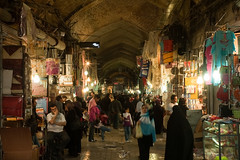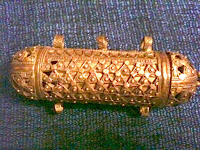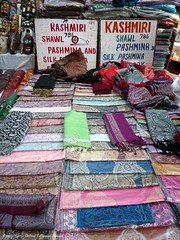 |
Tehran Bazaar by kamshots by kamshots
|
I didn't always enjoy shopping in the middle east. In Iran, I made my way through the bazaar often, but I didn't enjoy anything more than looking because in Iran bargaining usually involved trading insults. Bargaining went something like this in Tehran bazaars:
Prospective buyer says, "You want how much for that? You must be joking. It isn't worth half that."
In reply, the seller says, "Your offer is an insult! I wouldn't accept twice that amount. You clearly don't appreciate quality."
Or the salesperson simply grabbed the item out of my hands and put it back on the shelf.
Then there was the fact that my explanations for why I didn't want something were never accepted. "It's too small," I would say to explain why further discussion was not necessary, at which point the seller would lower the price. It took me far too long to realize that pointing out the flaws in the item was a buyer's strategy to get a lower price. I thought it was telling the truth.
But when I got to the other side of the Gulf that has two names, I noticed a different pattern. On the southern side of the Gulf, bargaining was a conversation among friends. Prospective buyers and sellers got to know one another, usually over a cup of tea or soft drinks, before discussion of prices came up. This was a much more pleasant way to shop.
I enjoyed shopping in the souqs in Doha, Abu Dhabi, Cairo, Dubai, Sharjah, Muscat, and Amman before I arrived in Sanaa. But I have never enjoyed shopping in the souqs more than in Yemen.
The souq in Sanaa's Old City is not like anywhere else, although Cairo's Khan el Khalili was impressive, too. The Old City is not just a marketplace. People live in the buildings there. It is a city within a city where getting lost was likely, but always a pleasant adventure.

|
 | |||
Badeehi-style pendant
|
Bowsani-style pendant
|
Bowsani-style bracelet
|
 |
|
| Necklace using Hadramaut design elements by Kamal Rubaih |
Necklace of grapes design by Kamal Rubaih |
 |
 by dietmut by dietmut |
I spent more time in the souq than in any other place in Sanaa except my house and my office. I never felt threatened or in danger. Wherever I went, I was surrounded by children who asked me for a pen or to take their picture. They offered to carry my bags and when we reached my car, they would go through the motions that they had seen over and over, presumably without realizing what it meant: they would walk around the car, leaning down and looking under it and in the wheel wells, precautions we took whenever we had left our vehicles unattended in a public area to ensure nothing had been planted. One day during Ramadan when I foolishly entered the souq in my car, not thinking about the fact that the alleys would be packed with shoppers since the fast had just been broken, two men walking alongside my car got my attention as they indicated they would fold my side-view mirrors against the car to reduce the width I needed to get through and then they directed other cars and pedestrians to move out of my way so that I could get through. I knew my guardian angel was on duty, and she had lots of help.


No comments:
Post a Comment